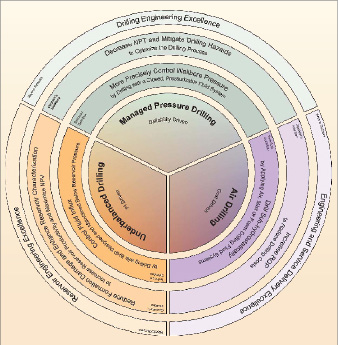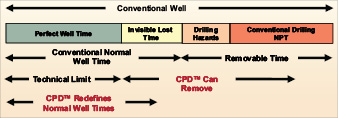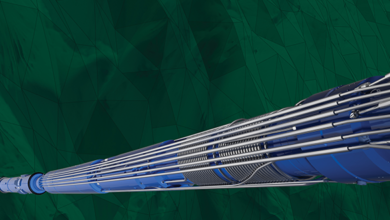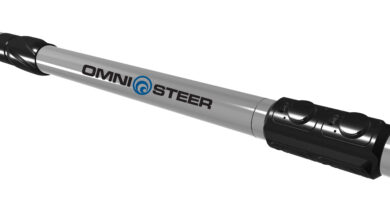Is your well suitable for controlled pressure drilling? Screening methodology could help you decide
By Said Boutalbi, Weatherford International Ltd
Controlled pressure drilling (CPD) is an adaptive drilling process that enables a more precise control of wellbore pressures. It is becoming an important tool for drilling aging fields with depleted reservoirs, narrow pressure windows and/or drilling issues. Improvements stem from mitigating common drilling hazards that are caused by lost circulation, kick/loss scenarios, sour-gas influx, or simply slow drilling through hard formations.

The drilling process can provide a variety of benefits during the drilling operation and production phase; however, it can fail to deliver full potential because unsuitable candidate wells are drilled or the inappropriate drilling technology is applied. An important aspect of CPD success is proper candidate screening, which can provide an understanding of benefits and risks.
This article provides an overview of an Internet-based tool and methodology that provides a quick, relative assessment of the applicability of CPD and feedback on the benefits on the various techniques.
While previous CPD screening expert systems and methodologies focused on underbalanced drilling (UBD), new enhancements have expanded the screening and assessment capabilities in the expert system to include air drilling (AD) and managed pressure drilling (MPD). Including these techniques expands missing capabilities and reflects change in industry focus since UBD technology has matured.
Current CPD growth is driven mainly by MPD while AD is more sporadic with huge potential. Primary demand for the technique is driven by NPT reduction from drilling hazards and reservoir productivity improvement from formation damage reduction.
Drilling Process
Oil companies spend millions of dollars every year attempting to manage and mitigate drilling hazards via traditional technologies that can be ineffective. The three CPD techniques – AD, UBD and MPD – can be used to address some of these hazards; however, MPD is the most appropriate to mitigate the majority of them because of the balanced approach and focus of the technique. CPD can address unscheduled events, drilling hazards and conventional drilling NPT along with invisible lost time (ILT) while MPD can help with wellbore instability. Unscheduled events that CPD can reduce or eliminate can be further classified as recordable NPT and ILT caused by weighted mud (Figure 2).
CPD can address the following recordable drilling issues that cause NPT:
• Lost circulation and differential sticking across low-pressure zones.
• Kick-loss scenario and multiple casing strings, i.e., narrow-pressure profile challenges.
• Fluid kicks or flow from high-pressure zones.
• Wellbore instability.
• Wellbore ballooning when excessive equivalent circulating density (ECD) causes cementation or formation breakdown.
• Slow ROP in hard formations or high-pressure formations
• Excessive water production from fractures and related cost.
Qualitative NPT impact can be classified as follows:
• Loss of or damage to assets (equipment, well, rig).
• Financial loss.
• Health, safety and environmental (HSE) issues.
• Public relations issues.
Invisible lost time: weighted mud NPT
During conventional drilling, bottomhole pressure (BHP) can only be managed or controlled by mud weight,

hydrostatic pressure and friction dynamic components. An adjustment to BHP requires interruptions to the drilling process (e.g., increase mud weight).
Many drilling-related problems and resulting flat time can be addressed to some degree by precise wellbore pressure management without major disruption to the drilling program and without an increase to the mud weight. This last aspect of conventional drilling is not scrutinized often (also referred to as invisible lost time, ILT). ILT causes NPT and adds to drilling cost by:
• Reduction in ROP: increase in overbalance pressure and mud weight reduces bit efficiency.
• Increased drilling costs: added mud cost and rig time.
• Increased well-control events: kick-loss, ballooning.
• Increased casing strings: Higher mud weight can fracture weaker, shallow formations.
Air drilling: cost-driven projects

AD is the original CPD technique used to reduce drilling cost by increasing ROP. Operators have relied on AD for decades to get through hard, fractured limestone formations quickly and without costly fluid losses. BHP is as low as possible to increase drilling performance when using this technique:
Pformation >>> Pbottomhole = Phydrostatic + Pfriction + Pchoke
The objective is to drill faster, which is achieved by using gas, air, mist or foam as the drilling fluid. Reducing the bottomhole circulation pressure significantly increases ROP. An additional benefit is increased bit life.
AD can be effective where there are hard formations, well control, lost circulation, reservoir impairment, excessive mud weight, and nuisance gas problems. It can be applied in surface, intermediate and production sections if other operational factors do not exclude it.
Managed pressure drilling:
drillability-driven projects
MPD is an adaptive drilling process used to more precisely control annular pressure profile throughout the wellbore. The term MPD was coined to cover situations in which the well is not intentionally encouraged to flow to surface during drilling, but the wellbore pressure profile is tightly managed with engineered equipment and processes. BHP is controlled in a way that eliminates many of the drilling and wellbore stability issues that are inherent to conventional drilling.
It is a drilling process that evolved from tools used originally in underbalanced drilling. Annular pressure is controlled in such a way that the well is balanced at all times:
Pformation = Pbottomhole = Phydrostatic + Pfriction + Pchoke
MPD can be valuable where you have tight-hole conditions, excessive mud weight, wellbore ballooning, hard formations, lost circulation, hole cleaning, well control, nuisance gas, and H2S issues. It can be applied in the intermediate and production sections if other operational factors do not exclude it.
The main MPD techniques are:
• Constant bottomhole pressure (CBHP): A variation of MPD that reduces NPT in narrow pressure gradient windows by avoiding kick-loss cycles that reduce the amount of casing strings and depth.
• Pressurized mud-cap drilling (PMCD): A variation of MPD that solves the problem of mud losses into thief zones or extreme-loss situations that can reduce flat time, increase ROP and reduce drilling mud cost.
Underbalanced drilling:
productivity-driven projects
While the previous two drilling techniques focus primarily on improving drilling hazards, UBD emphasizes reservoir protection. The reservoir section is drilled below the pore pressure, resulting in a controlled influx of the reservoir fluids, to minimize or eliminate drilling-induced formation damage. When drilling underbalanced, the effective downhole pressure within the wellbore is always maintained below the reservoir pressure, and it is intended to have reservoir influx into the wellbore.
Pformation > Pbottomhole = Phydrostatic + Pfriction + Pchoke
This technique minimizes formation damage problems and improves productivity, particularly in open-hole horizontal well applications. It can also be used to improve reservoir characterization by measuring flow while drilling and drilling performance (i.e., increase ROP and bit life). However, the primary focus is productivity improvement.
UBD is not a solution to address all production issues and may not be applicable in some reservoirs because of operational risks (i.e., borehole stability) or effectiveness of the technique (i.e., tight reservoirs). It can be valuable where you have reservoir impairment, excessive mud weight, wellbore ballooning, hard formations, lost circulation, hole cleaning, and well control issues. The primary application is while drilling the production section if other operational or technical factors do not exclude it.
Screening
CPD has proven effective in eliminating or reducing many issues that are encountered during conventional or overbalanced drilling. However, a formalized method for better understanding what technique to use and why had been lacking. This missing piece in screening all CPD techniques has caused some misapplications.
CPD screening capabilities have now been expanded. In addition to candidate screening, the process can also provide feedback as to why a technique may or may not be suitable. The online screening process is divided into two parts – selection guidance and an expert system to screen for each CPD method. This is a starting point for investigating CPD options and benefits, which is part of a full candidate selection, evaluation, planning and execution system.
Selection guidance
The selection guidance can be used when there is uncertainty about which CPD process to select or whether more options should be considered. This guidance component uses a questionnaire based on a variety of user- and well-specific parameters to indicate which CPD can be considered further or is feasible.

In addition, if one technique is excluded, it provides information on why, which can be used to make adjustments if necessary. This aspect of the CPD selection guidance can also be used to test uncertain aspects of the well program and impact on CPD. The online tool provides CPD guidance based on the following parameters:
• Hole section: top, intermediate or reservoir.
• Presence of shale and coal.
• Well orientation direction.
• Drilling objectives: NPT, formation damage.
• Directional drilling requirements.
• Source of NPT.
• Hole size.
• Presence of drilling hazards.
Screening
When a specific CPD technique is chosen, the online screening tool considers a range of economic and technical parameters, supplied by the user, to evaluate the suitability of the chosen technique. Figure 4 further illustrates the online CPD selection process. The screening system is a risk-based, low-resolution tool and is designed to provide a relative assessment of the applicability of CPD candidate wells. Intentions are to quickly screen CPD candidates based on limited data. Sensitivity analysis can be performed on several parameters.
MPD: screening logic
The MPD expert screening system incorporates economic and time analysis and fuzzy logic. Algorithms and fuzzy logic rules are used to handle situations when a factor is not strictly true or false. It allows partial truth and assigns a value to this factor through a mathematical evaluation of the trueness. The applicability of MPD depends on:
• Likelihood and severity of events or hazards happening during conventional drilling.
• Improvement of ROP.
• Improvement of HSE conditions (MPD).
• Relative economics vs conventional drilling.
Candidate suitability is quantitative and relative to conventional techniques for the online tool, whereas the full expert system provides a more comprehensive and qualitative analysis. The online suitability tool requires the following input parameters (Figure 5) to estimate the suitability for MPD:
• Well depth.
• Lost-in-hole events.
• Mud details.
• Wellbore ballooning and/or fracture charging.
• Lost-circulation events.
• Well control events.
• Differential sticking events.
• Conventional costs and duration.
 MPD candidacy is determined using three modules – time, H2S and intermediate casing score. Candidacy is primarily determined by how much time can be saved by using MPD compared with using conventional techniques. The following points are considered for a time comparison:
MPD candidacy is determined using three modules – time, H2S and intermediate casing score. Candidacy is primarily determined by how much time can be saved by using MPD compared with using conventional techniques. The following points are considered for a time comparison:
• Time needed for conventional drilling without problems (TConventional).
• ROP time savings (ΔTROP).
• Time delays caused by drilling hazards, occurring when using conventional techniques (ΔTHazards).
• Additional time needed when using MPD techniques, resulting from added operational complexity (ΔTMPD).
Time savings score is calculated as follows:
A positive ΔT indicates that MPD is beneficial by reducing drilling time compared with using conventional drilling techniques. Candidacy results can be classified into three categories. First, a negative time saving indicates that conventional techniques might be preferable. Secondly, a significant time saving indicates that MPD techniques are more suitable. In the third category, there are time savings but these are not significant, and further assessment may be required to determine the best drilling application. Fuzzy logic is used to mathematically express partial truth through the use of membership functions.
The upper and lower boundaries in the membership functions are dependent on the location and rig type. This option is provided for situations where conventional costs are lower (i.e., onshore locations for shallow to moderate depths) compared with higher-cost scenarios (i.e., ultra-deep onshore and offshore).
In the lower-cost scenario, you may need more time savings to validate an MPD operation compared with a situation with high daily rates.
In addition to the time-savings score, other factors influencing the MPD candidacy final score are H2S and intermediate casing score. If H2S is present in the formation fluids, MPD will become more favorable. The closed and pressurizable system used in MPD operations are conducive to containing H2S releases or continuous H2S flow while drilling the well.
The capability of MPD to tightly control BHP can also reduce intermediate casing strings. This capability is accounted for and improves the suitability (total score). Total candidacy score is the sum of the time savings, H2S, and intermediate modular score.

AD: screening logic
Air drilling candidacy is calculated using a similar process as for MPD. The time score methodology is the same, and the time score is the only positive score for AD because the objective when using AD is to increase ROP and thereby reduce costs. A major deviation in approach is that AD considers the following exclusionary factors:
• H2S.
• Oil influx.
• Water influx.
• Borehole instability.
Exclusionary factors are conditions that reduce success of AD by adding operational and safety risks. The total AD candidacy score is the time score minus the exclusionary factors.
Case studies
Air drilling
Two case studies are presented here to demonstrate different applications of AD. Normally AD can be effectively applied for all sections of the wellbore, if operational procedures permit.
An onshore shale gas in West Texas was air-drilled. Implementing AD provided the following results:
• The bit life in the system was prolonged as the compressed air cooled the bit, and the cutting rates in rock were improved by the air carrying the cuttings away from the drill bit.
• Since the BHCP was maintained as low as possible, the ROPs increased significantly.
• Lost circulation was eliminated.
• Cost savings of 64% (USD$164,000) were achieved.
In the second study, the technique is applied in the reservoir section along with a downhole isolation valve, which was the first instance where the two systems were applied in the Appalachian basin. Combining the method and isolation equipment allowed for safe installation of the production and completion assembly while underbalanced. Productivity was improved by:
• Drilling and completing without incident, using mechanical and hydraulic analysis calculations to prevent downtime or failure.
• Minimized/eliminated formation damage in water-sensitive gas shale by isolating formation, avoiding fluid contact.
• Saved rig time and cost because no drilling mud was required during the drilling operation. Since this initial operation, 11 other operations have been executed.
Managed pressure drilling
The three case histories here demonstrate a variety of MPD techniques. The first is a Canadian nuisance gas zone above the pay zone that reduced ROP and caused NPT. Applying constant BHP (CBHP) MPD enabled the successful bleeding of the nuisance gas, allowing drilling to continue to TD and providing the following benefits:
• Drilling efficiency was improved by lowering the required mud weight, and the ROP was more than doubled.
• Safety was enhanced by avoiding kick/loss problems that had occurred when the previous service company encountered the high-pressure, low-volume zone
• Cost savings of 20% were achieved.
A Gulf of Mexico operator encountered fluid loss-related NPT when drilling a formation using conventional drilling. The next well was drilled using CBHP MPD with the following results:
• Successfully drilled with no loss of circulation.
• Drilling time was reduced from 30 days to 5 days (83% reduction).
• Mud cost savings exceeded US$1 million.
MPD is now the operator’s standard procedure in the field.
The third case study is an offshore Malaysian carbonate formation that suffered total fluid loss when conventional drilling methods were used. In this case, PMCD MPD was successfully implemented, allowing the well to be completed as planned with the following results:
• Eliminated all fluid loss NPT.
• Optimized process and successfully drilled two offset wells that were previously considered undrillable.
Likewise, MPD is now the operator’s standard procedure in the field.
Underbalanced drilling
Given the primary goal of UBD (preserving reservoir productivity by reducing formation damage), UBD is most effective when applied in the reservoir section or primary production objective. Two case studies will be discussed to illustrate the potential impact of UBD.
The first is an Omani fractured limestone with objectives that included increased productivity and reservoir characterization. Two laterals, totaling 3,025 ft (922 m), were successfully drilled underbalanced with the following results:
• Upon testing, the Natih reservoir well produced 11.03 MMscfpd of gas and 793 bpd of 57 API condensate.
• The successful characterization of both reservoirs while drilling significantly increased productivity and while significantly minimizing the possibility of formation damage. Adjustments were made to the completion strategy, based on faults intersected and water production.
In addition to the reservoir benefits, UBD also mitigated NPT caused by lost circulation, reduced ROP, and differential sticking.
This second case history demonstrates how North Sea operators have used UBD to extend the economic life of the field in fractured limestone reservoirs. Implementing UBD and completion methods has:
• Increased their field production rates by more than 300%.
• Adjusted completion program according to well productivity by using reservoir characterization while drilling.
• Mitigated NPT for lost circulation, differential sticking, and reduced ROP.
Conclusions
Although CPD can provide many advantages, it is not a universal solution that addresses all operational hazards and productivity in marginal fields. Proper CPD candidate selection is needed in order to eliminate misapplications and failures.
This article is based on SPE 120035, “Controlled Pressure Drilling (CPD) Candidate Screening Methodology,” 2009 SPE Middle East Oil & Gas Show and Conference, Bahrain, 15-18 March 2009.
For article references and acknowledgments, go online to www.DrillingContractor.org.




